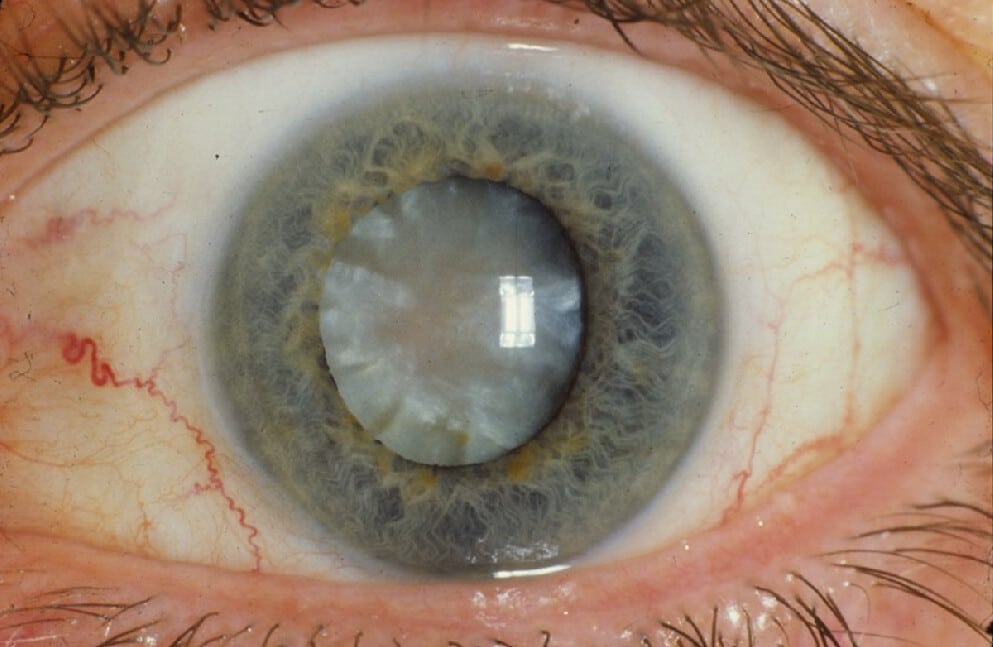What is a cataract?
The cataract is a consequence of the crystalline lens growing old. I know it sounds bonkers, let’s go one step at a time.
The crystalline is a lens we all have and allows us to focus at different distances. I’ve marked it with an arrow on the drawing below these lines:

This lens should, as its name hints, be crystal clear. As years go by, this lens loses its transparency. However, given a certain point in life, this lens turns brownish and darker. It’s then when we talk about “a cataract”. As the disease evolves, the lens may turn into dark brown, black or, more often than not, white.

So, cataract is something that grows on our eyes, right?
No, it’s not, it’s the darkening of the crystalline, something we are all born with.
This is soooo not happening to me
Well… The cataract is an extremely common disease, starting with people in their 60s, though it can also be diagnosed in younger patients every once in a while. So, given enough time, I’m certain you’re going to develop a cataract.
And this is not solved by wearing glasses?
No, glasses help our eyes to focus better, but don’t make dark lenses turn more transparent. The only path to fix it is surgery.
Ok then… Let me know when the time comes
This varies greatly among patients. Every patient is unique and has different visual needs. Requirements and visual needs show a broad range of variety depending on the person. There is no such thing as “the perfect time to get the surgery done”. We usually let the cataract develop till the patient decides the time has come. However, the more the cataract develops, the harder it gets. Once it reaches the “mature” phase, the surgery is riskier and more complicated. We prefer to avoid this stage of the disease and get the surgery done before this happens.
On one hand, a professional driver may feel limited with a visual acuity of a 70%, while others may feel comfortable with just a 30% of their vision.

How does a normal surgery day go?
Usually the patient arrives to the Clinic early in the morning and registers himself at the information desk. Then, he’s led to the changing room, where clothes are left.
The next step is the preparation room. A vein will be accessed – just in case we need some treatment during the surgery – and a relaxing pill is given. Here begins the eye treatment for the surgery: some anesthetic drops and a small pill is applied under the eyelid.
The nurse will be checking the pupil widening. Depending on the surgery timetable, the patient may have to wait between one and two hours. After, he will be carried to the surgery room.
Once there, the surgeon (me) will give a short briefing on the surgery: it lasts for 10-15 minutes, you may feel some itching or pressure…
Finally, the eye is covered and the patient is brought back to the preparation room. After 15-30 minutes of resting, the patient is accompanied to the changing room.
Oh! Wait! You actually skipped HOW is the surgery performed!!
Cataract surgery is usually micro invasive without any sedative. This means that the wound is usually 2.4 mm wide and the patient is awake during the “entire” procedure (10-15 minutes). Through the incision, more anesthesia is applied and a device is inserted, capable of pulverizing and sucking out the cataract.
Once removed and through the very same incision, the lens is inserted. Folded at first, it unfolds itself inside the eye. Antibiotics are given, the would is closed and the eye is covered. Done.
Is a lens always inserted?
Yes, indeed. It will attach itself to the eye, last for your lifetime and doesn’t need to be changed. There are lots of different lenses, we’ll develop this issue on another article.
And what about the laser?
Currently the laser is only capable of making the initial incision and perform a very mild pulverization of the cataract. It is unable to complete de crushing and removal of the cataract. Moreover, the lens cannot be inserted by the laser machine.
Therefore, taking into account the cost of the laser and its limitations, it’s considered a marketing tool. Some centers must have it, but its current benefits, when it comes down to the actual surgery, are very limited. And it would make the surgery significantly more expensive. This is as of today, October 2020, but may change in a near future.
For those of you with further interest, I’m leaving a real surgery video. The video is already a few years old, the wound is currently smaller and the speed of the procedure has been increased.
For further information, visit the Wikipedia page, which is surprisingly good: Cataracts.
Feel free to contact us whenever you feel your vision is blurry or just tired of your glasses.